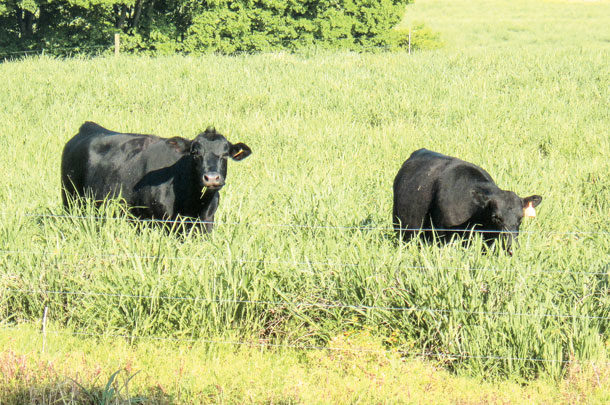Some of the impact of these droughts may have been offset if producers in the region had reliable, drought-resilient summer forages.
For all of the benefits of tall fescue, it was never meant to provide our summer forage. After all, it is a cool-season grass. What we have been learning about toxicosis in recent years further emphasizes the value of having alternative forages available during summer months.
Complementing tall fescue
Having a summer perennial may be one of the best tools we have for managing tall fescue. Why do I say that? Tall fescue, like any grass, is most productive when it gets some rest during the growing season.
If we continue to push cool-season pastures well into the summer and/or during substantial dry periods, we weaken the grass, shorten stand life and create an opportunity for all sorts of less desirable species to dominate our pastures.
Once these less desirable grasses (goosegrass, foxtails, common bermudagrass) or weeds (pigweeds, horsenettle) become established during such conditions, they will be a problem for years to come.
The best way to avoid this situation is not to let it start. Resting tall fescue also provides an opportunity for stockpiling – a proven way to lengthen the grazing season and reduce feeding or producing hay.
One option that producers should consider, an option that has received only modest attention, is native warm-season grasses (NWSG). Specifically, species such as big bluestem, indiangrass, switchgrass, and eastern gamagrass should be considered summer forages in our region. All of these are long-lived perennials with exceptional drought tolerance.
These species cannot and should not replace tall fescue; rather they can be a valuable complement in a balanced forage system. Having 10 to 35 percent of a forage base in warm-season perennials such as these has been recommended for extending grazing and minimizing feeding more expensive rations during summer dry spells.
Initial production research
To understand what NWSG could and could not do in a production setting (including yield, stocking rates and animal gain), we conducted a grazing study on switchgrass (SG), a big bluestem/indiangrass blend (BB/IG), and eastern gamagrass (EG) using weaned steers.
Researchers often use steers in grazing studies because they are more sensitive to forage quality than other animal classes and therefore allow for better evaluation of differences among forages.
One lesson we learned from this study was that these grasses had higher carrying capacities than we had anticipated. Based on 60 units of nitrogen (N) per acre applied each spring (late April), we were able to carry well over 1,000 pounds of live animal per acre, season long (Figure 1).

Switchgrass was especially productive, reaching a peak in late May or early June of 2,500 pounds per acre. This stocking translates into 145 animal unit days (AUD) per acre for BB/IG, 198 for SG, and 206 for EG.
With respect to gains, BB/IG produced 2.11 pounds average daily gain (ADG), SG 1.74, and EG 1.06. Because SG had high stocking and high rates of gain, it produced the most beef per acre (435 pounds) and big bluestem, due to its lower stocking rate (despite higher ADG), produced only 369 pounds.
Because of the number of pasture replicates and the three-year duration of this study, we were able to calculate reliable monthly averages for ADG. This showed us that ADG remained strong through July (at or above about 1.5 lb per day for both SG and BB/IG), the first 90-100 days of the grazing season. In August, gains dropped to about 0.80 pounds per day for these same species.
While 0.80 pounds per day is modest, keep in mind what the alternatives are during August with other forages. Tall fescue will be at or below this ADG and should be rested at this time to allow for adequate fall forage/stockpiling.
Other warm-season grasses are performing at – or, in the case of common bermudagrass – below this level. Keeping cattle on NWSG during August will, at a minimum, allow cool-season forages a very strategic rest. Based on this initial study, it was clear that native grasses could produce good gains and sustain high stocking rates.
Inter-seeding legumes
A second study was implemented in 2010-2012, evaluating use of legumes in NWSG pastures. We grazed bred dairy heifers on SG and BB/IG, but included a legume inter-seeding treatment (red clover seeded annually at 5 pounds per acre in mid-February).
We learned that although the clover made modest contributions to improved forage quality (reduced fiber in two periods, increased protein in another) and animal performance (AUD in one period), it never improved total beef production for either grass.
We also observed that when red clover became quite abundant, it created excessive and unacceptable levels of competition with the BB/IG during spring, especially in April. At least for this legume, there did not appear to be much justification for inter-seeding with NWSG.
Economics
We worked with our agricultural economists to provide some analyses of these two initial studies. Those analyses indicated that the most favorable return from grazing was from SG. This was because annualized pasture costs varied only slightly while production per acre averaged across both study sites was greater for SG.
Net returns were positive for all locations/species grazed, indicating that it was more profitable to graze steers on NWSG over the summer than marketing them in May.
It was also apparent that management exerted a great deal of influence over total gains and, in turn, returns per acre. With good management, SG produced returns of $345 per acre and BB/IG $257 per acre.
For the legume study, SG was again the most economical choice with per-head grazing costs of $0.48 per day versus $0.79 per day for BB/IG. Again, this was a result of greater carrying capacity and slightly lower seed cost. Inter-seeding legumes was not cost-effective given the lack of animal response combined with increased annual costs for planting.
Regardless, all NWSG options were cheaper than diets providing comparable rates of gain but with traditional commodity feedstuffs (e.g., $1.96 per head per day for corn silage with dry distillers grains, $2.77 for corn silage with soybean meal). Finally, cost per pound of gain for SG was $0.31 and for BB/IG $0.40.
Management studies
These projects emphasized that NWSG can provide high stocking rates, good to very good rates of gain, don’t necessarily benefit from inter-seeding with legumes, provide good profit margins and have many advantages over summer annuals. All of this suggests that NWSG may be a reasonable complement to tall fescue-based pasture systems.
But how do we use this tool – how can we best manage NWSG pastures? This is an important question, especially since some have considered NWSG “difficult” to manage. Indeed, a common recommendation has been to use some form of rotational grazing for NWSG. We have implemented two studies, both still underway, that address management.
A study initiated in 2015 evaluates two grazing strategies for BB/IG pastures. The first is simple, continuous, season-long grazing with a set stocking rate that we based on our initial production study.
The second strategy involved using a heavier stocking rate during the early part of the season when growth was stronger, and then reducing stocking in late June when pasture productivity was declining (Figure 2).

We were particularly interested in determining if either of these “low input” management approaches were viable and also understanding how they impacted production.
This study also represented a change from our earlier trials in that we used 25-acre pastures to evaluate the practicality of these approaches in more typical production settings. Our earlier work had been on 3-acre experimental pastures. No N was applied in this trial.
From this study we learned that it was possible to manage BB/IG pastures at a production scale using continuous grazing strategies. We were able to sustain grazing throughout the season and, for both treatments, end the season with swards that did not appear to have been damaged or stressed.
The key, we believe, is maintaining adequate canopy heights throughout the season – something our stocking rates permitted.
A second management study uses two other strategies: traditional rotational grazing with three paddocks and patch-burn grazing. Patch-burn grazing (PBG) is an approach that mimics rotational grazing by distributing grazing pressure across a pasture based on annual burning. In our case, we burn one-third of the pasture annually.
Cattle preferentially select the current year’s burn for grazing. Areas burned the previous year are grazed less intensively, and those burned two years previously are grazed the least. Thus a pasture has grazing pressure distributed over a three-year cycle, allowing adequate rest for each portion of the pasture (albeit in different years) without requiring cattle to be moved during the season, cross fencing or additional waterers.
This system has been used effectively in the Great Plains, but has received little attention in the eastern U.S.
Our first burn – and grazing summer – was in 2015. We learned that, depending on stocking rate and amount of time elapsed between burning and initiation of grazing, PBG results in selective grazing as intended.
Lighter stocking rates, which allow for greater selectivity by grazing animals, and earlier stocking following the burn (greater difference in palatability/quality of the forage in burned versus unburned) both increase selectivity. When stocking occurred well after the burn and at higher rates, we saw very little selectivity.
Rates of gain on the yearling dairy heifers we used in 2015 were similar between treatments (1.64 versus 1.61 pounds per day for rotational and PBG, respectively). We were able to graze for 105 days and achieved rates of gain very appropriate for heifer development.
Conclusions
Based on our research to date, it appears that NWSG can provide a valuable, high-quality source of summer forage that can effectively complement our tall fescue production systems. However, many producers, and even agricultural professionals, are not very familiar with this tool.
Our research also has demonstrated that NWSG are not really that difficult to manage. It simply requires maintaining appropriate canopy heights, something that is, after all, true for any forage. Our NWSG just require taller residual heights than many of our other forages with which we are more familiar. Continuous, rotational, and probably even PBG, can all be used effectively to manage for proper canopy heights.
Establishment is a concern, but here again, our studies have shown that with reasonable attention to detail – especially good, advanced competition control – NWSG can be successfully established and can be grazed beginning the summer following seeding.
Producers should consider establishing some NWSG on a small scale, perhaps where they already have a reseeding project, on new ground, ground coming out of row crops or in odd areas. Based on your experience, you can always plant more later.
However, none of us knows when the next severe drought will occur. Getting a reliable, highly drought-tolerant, warm-season perennial in place now is the best way to prepare for the inevitable. FG
PHOTO: Cattle graze an eastern gamagrass pasture in eastern Tennessee on a hot afternoon. While gamagrass cannot and should not replace tall fescue, it can be a valuable complement in a balanced forage system. Photo provided by Pat Keyser.

-
Pat Keyser
- Center for Native Grasslands Management
- University of Tennessee
- Email Pat Keyser











